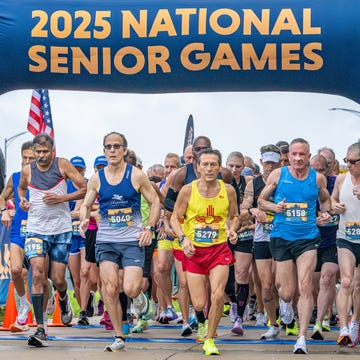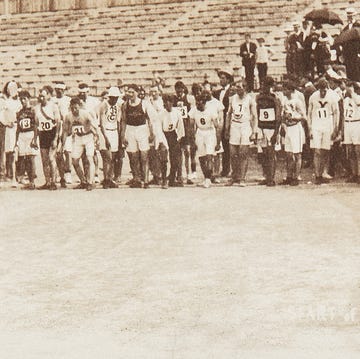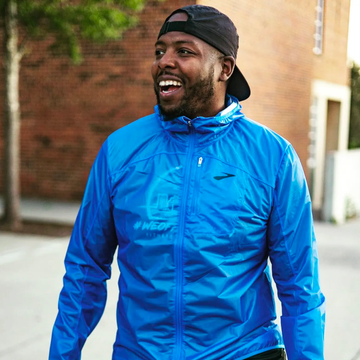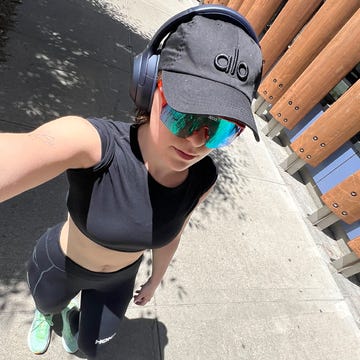In the quiet moments prior to a race, Patrick Anderson meditates. Before the crowd roars from the sidelines and competitors battle for position on the track, he finds a calm state of mind. For Anderson, it’s not so much about pre-race nerves, it’s about acceptance.
Almost two years since surviving a near-fatal car accident on the way to practice, the University of North Carolina standout still deals with intermittent headaches from a traumatic brain injury. Prolonged screen time at school and running hard efforts are all things that can trigger the pain.
But instead of hoping the headache will never come in a race, Anderson prepares himself. After three surgeries to repair dozens of broken bones and months of rehabilitation (with some doctors doubting if he’d ever be able to run again), he’s found a way to run through it, faster than ever before.
On February 1, Anderson achieved his long-time goal of breaking the four-minute barrier in the mile. At the Boston University John Thomas Terrier Classic, he ran 3:58.69 to win his heat, crossing the finish line with his arms outstretched. “Running is starting to trend upwards,” Anderson said. “My first lifetime PR post-accident, it’s a good boost of confidence.”
Like his teammate Anderson, Will Coogan has a different mindset when it comes to racing these days. Coogan also suffered from a severe concussion during the accident and still deals with headaches today. Before the crash, the teammates often got caught up in the common trap of attaching their self-worth to performances. At times, the pressure of competing at the collegiate level clouded their appreciation for the opportunities in front of them.
Now, when they line up to race, both athletes take an intentional deep breath at the start line. Instead of feeling anxious, they take in their surroundings. They look around to see their teammates next to them, their coaches on the sidelines, the energy of the crowd watching, and each other. At that moment, Anderson and Coogan don’t think too much about chasing times or a place on the podium. All they want to do is run their best, which is more than enough.
“We went through some hard stuff these last two years that we didn’t choose, but we had to do it,” Coogan said. “Training and racing is something we get to do. In the middle of a race, when it’s the hardest, that’s the perspective we have now.”
A season cut short
The crash took place when the UNC distance runners were driving to meet for the team’s weekly long run. Just two days prior, several athletes ran personal bests at the 2023 Raleigh Relays, a college meet that attracts top talent from all over the east coast. The outdoor track season had just begun, and with it came the promise of new goals to chase.
A caravan from the men’s and women’s squads approached the American Tobacco Trail. As they neared the trailhead close to campus in Chapel Hill, one car carrying five runners on the men’s team made a left hand turn. In a fateful second, a painters’ truck heading in the opposite direction crashed into the side of the car, sending the vehicle rolling twice before landing in a ditch. Wet paint and ladders scattered across the asphalt as everyone tried to make sense of what happened.
Three of the runners walked away with minor injuries from the accident. But Coogan and Anderson were pulled from the wreckage in critical condition—Anderson nearly dying from his injuries. The pair don’t remember much after the truck hit them, but Anderson faintly recalls the moment his teammate, Jesse Hunt, held him in his arms, Anderson’s face barely recognizable as blood began to pool in his eyes and mouth.
“Keep going, mate. It’s going to be alright. It’s just a few scrapes,” Hunt told Anderson while they waited in desperation for the ambulance to arrive.
The ones that ‘bought in’
Though they grew up in different cities, Coogan and Anderson were meant to run on a team together one day. From his hometown of Pittsburgh, Pennsylvania, Anderson was the first recruit Chris Miltenberg called when he took the job as UNC’s director of track and field and cross-country in July 2019. Coogan, from Exeter, New Hampshire, followed soon after.
That fall, Anderson finished third as a senior at the 2019 Foot Locker Cross-Country Championships, one of the most prestigious high school meets in the country. During his senior year, Coogan clocked solid indoor track times of 1:53.71 in the 800 meters and 3:56.69 in the 1500 meters before the pandemic canceled the rest of his season. Miltenberg also coached Coogan’s older sister, Katrina, while leading the program at Georgetown years earlier.
When Miltenberg recruited Coogan and Anderson, he saw them as key players in building what is now a powerhouse distance running program. “They were my first two recruits here,” Miltenberg said. “They were the guys that bought in when it was a distant vision.”
Though their college careers started with virtual classes during the pandemic, it didn’t take long for the runners to emerge as dependable contributors within a team on the rise. During the 2022 cross-country season, Anderson and Coogan finished as the winning squad’s No. 2 and No. 3 scorers, respectively, at the NCAA Southeast Region Championships. UNC went on to finish 10th at the 2022 NCAA Cross-Country Championships—the team’s best finish at the national meet since 1985.
The following winter, they continued the momentum. In February 2023, Anderson clocked 13:42.53, then a personal best for 5,000 meters. Coogan ran personal bests in the 3,000 (7:54.66) and 5,000 meters (13:44.64) before blazing another PR in the 1500 meters (3:44.13) at Raleigh Relays. It was shaping up to be their best track season to date.
Assessing the damage
When the truck hit them, Anderson was sitting in the front passenger seat, and Coogan was in the middle of the back row. Right away, their teammates—Hunt, John Tatter, and Marshall Williamson—jumped into action, calling 911 and then Miltenberg. Together, they lifted Anderson out of the car, which had landed on its side. Coogan was trapped in the backseat and had to be removed by first responders.
The crash left Anderson with 25 shattered bones in his face, his spine fractured in four places, and broken bones in his hand. Coogan had a severe concussion, lacerations on his face, and internal bleeding in his stomach. Both were unconscious when the ambulance arrived to take them to the hospital.
While Miltenberg followed the ambulances in his car, he called Anderson’s mom, Meghan Anderson. The family was in town to watch Anderson race in Raleigh and were getting ready to meet him for lunch after his long run. “It’s that call no parent ever wants to get,” Meghan said.
Miltenberg also called Coogan’s dad, a 1996 Olympian and the head coach of Team New Balance Boston, Mark Coogan, who was reading the newspaper at home in Newburyport, Massachusetts. He thought Miltenberg wanted to chat about his son’s great race in Raleigh. He never imagined the horrible reality. “When [Miltenberg] hung up, Will was still unconscious,” Mark said. “It rattled me.”
Both families soon arrived at the hospital with Coogan’s family flying in from Boston and Atlanta. When Anderson’s family came into the emergency room, the first person who approached them was the chaplain.
Seeing Anderson for the first time, his face swollen and covered in blood, they learned the extent of his injuries. Meghan said the doctors told her they stopped counting how many bones were broken in his face once they got well into the 20s. Though the injuries were severe, they were reassured he didn’t have a brain bleed or spinal cord injury that would leave him paralyzed. The family also felt hopeful once Anderson started speaking. Though he couldn’t open his eyes, he told them, “I’m just a little banged up. I’m going to be alright.”
With coaches and teammates visiting him every day in the hospital, Anderson underwent two surgeries on his face and one on his hand. Anderson said his focus during the first week was to simply keep fighting for every breath. In week two, he got out of bed for the first time, a major victory considering the excruciating pain of multiple spinal fractures. After spending three weeks in the hospital—and gradually walking more steps each day—Anderson was released for a long-term physical therapy plan.
After being examined at the hospital immediately following the accident in the morning, Coogan was released that night. Mark said the doctors told them that though he suffered from a major concussion and internal bleeding, he would ultimately be okay. Mark, Coogan’s mother Gwynneth, and sisters Katrina and Margaret, stayed in Chapel Hill for a few days before making plans to return home.
“We thought William was getting better pretty quickly, but it took a turn for the worse,” Mark said.
Navigating the unpredictable
As Coogan and Anderson soon learned, the recovery timeline for a traumatic brain injury (TBI) or concussion is far from linear. At first, Coogan went back to school and tried to run one week after the accident, but constant headaches plagued him and were made worse from screen time required for schoolwork. On top of the broken bones and surgeries, Anderson also had to navigate the complicated recovery process of TBI for months. That spring, both runners took a medical leave from school and went home to heal and face the many unknowns in the aftermath of the crash.
“There’s not a set recovery plan for a brain injury like that, so just trying to balance doing stuff, getting better with the pain of headaches was the hardest part,” Coogan said.
For months, both runners were confined to dark rooms, unable to read, look at screens, or even be in sunlight as the stimulation would often trigger debilitating headaches. If they were able to, they’d listen to audiobooks or work on hand-eye coordination activities, like building Lego sets and other exercises recommended by physical therapists and neurologists. On a good day, they’d go for short walks outside.
Mark said one of the toughest parts of the ordeal was noticing a personality shift in his son. For months, the once smiling, happy kid would rub his head in pain and walk up to his room and sit in silence. To support Coogan through it all, Mark tried to stay positive while listening to how Coogan was feeling, making his favorite meals, like “dad’s famous nachos,” and watching sports together. They even attended a Celtics playoff game with Coogan wearing sunglasses and headphones.
Even though every doctor assured them he would eventually get better, the timeline of recovery differs for each person and the severity of their brain injury. “Some people, [concussions] go away in a couple of weeks, and some people it takes two or three years, and William’s is going to be long term,” Mark said. “It was really hard. He’s like, my best buddy ever … I don’t know what I would do without that kid.”
During Anderson’s recovery, much of the focus was on goal-setting and celebrating milestones—big and small—to move forward. Looking back on the moments in the hospital and recovery at home, Meghan said she was in awe at her son’s ability to battle through self-doubt in the darkest times. “He’s full of grit, and he works really hard,” she said. “And boy, those things never played out so much as they did through this.”
Though they were hundreds of miles apart, Anderson and Coogan were a major source of support to each other. If one of them suffered from a throbbing 48-hour headache, the other would call them from a walk around their house. In addition to frequent check-ins, they also shared motivational quotes and audiobook recommendations, many of which focused on stories of extreme resilience. One of their favorites is “Man’s Search for Meaning,” a memoir by psychiatrist and Holocaust survivor Viktor E. Frankl.
“[When you have a concussion] it may look like you’re fine, but really you’re in a lot of pain, it’s hard to do other things, and you get down on yourself,” Anderson said. “Having someone that was going through it, even though our injuries were different, we had an understanding of what we were going through. The biggest thing was we were able to keep each other going.”
Regaining strength
In the fall of 2023, Coogan and Anderson returned to school and continued ongoing treatment with the same neurologist in Chapel Hill. About five months after the car accident, Anderson took his first jog outside of the doctor’s office. Even though it was only 20 or 30 painful steps—his back still aching from the newly healed fractures—Anderson said he smiled the whole time. “To move your body like that again when for weeks you thought you might never, was really cool,” he said.
Following a slow return to running plan, with a few stops and restarts in figuring out how to manage the headaches, Coogan and Anderson were able to resume their training with the team in January 2024.
Almost a year after the accident, Anderson raced the 1500 meters at the 2024 Raleigh Relays in late March. A week later, Coogan made his return in the 1500 meters, and Anderson ran in a separate heat at the 2024 Duke Invitational.
As Miltenberg recalled, both were disappointed in their times at Duke. While walking out of the stadium, he reminded them, as he had for months, to have an “attitude of gratitude” given their past year of struggles. “Both of them, in the most polite way, were like, ‘Hey, we’re sick of hearing that. We also want to be freaking good at this,’” Miltenberg said. “It was actually awesome because you’re like, man, that’s the real them. They’re still in there.”
In late April, Coogan and Anderson were scheduled to race the 5,000 meters at a meet in Charlotte, North Carolina. A week before the competition, the weather forecast showed high temperatures, which they learned can trigger the athletes’ headaches. Miltenberg and assistant coach Ian Moini started looking for competitions in cooler weather and decided to try Penn Relays. Five days before the race in Philadelphia, Miltenberg asked UPenn head coach Steve Dolan for two last-minute entries as a favor.
On the night of April 25, Coogan and Anderson raced together for the first time since the accident. Under the lights of Franklin Field, Coogan pulled away over the last two laps to win the 5,000 meters in 13:52.60. Anderson was right behind him in 13:53.86 for third. Both came close to their personal bests in the event. “That was when we realized, this is not just going to be a feel-good story of them getting to run again. They were really going to do it,” Miltenberg said. “That was one of the most powerful nights of my life.”
Later that spring, Coogan smashed his personal best in the 1500 meters, running 3:41.84 in Concord, Massachusetts. By the fall, both athletes regained their place as consistent contributors on the UNC cross-country team, scoring for the squad’s sixth-place finish at the 2024 NCAA Cross-Country Championships in Madison, Wisconsin. In February, Anderson followed his personal best in the mile with another PR in the 5,000 meters (13:37.15). Coogan also clocked a personal best in the mile (4:01.41).
Now almost two years since the accident, they still deal with intermittent headaches, but they’ve both seen major improvement in recent months. To help manage the headaches, Anderson is seeing concussion specialists who are guiding him through vestibular rehabilitation therapy, which uses exercises to address dizziness and balance impairments. Coogan has also taken a proactive approach by not letting the pain of headaches keep him from doing what he loves.
“I try to remind myself that it doesn’t have power over me,” Coogan said.
These days, he feels most at home when he’s running with his teammates.
Taylor Dutch is a writer and editor living in Austin, Texas, and a former NCAA track athlete who specializes in fitness, wellness, and endurance sports coverage. Her work has appeared in Runner’s World, SELF, Bicycling, Outside, and Podium Runner.


















